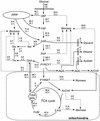Identification of in vivo enzyme activities in the cometabolism of glucose and acetate by Saccharomyces cerevisiae by using 13C-labeled substrates
- PMID: 12796305
- PMCID: PMC161459
- DOI: 10.1128/EC.2.3.599-608.2003
Identification of in vivo enzyme activities in the cometabolism of glucose and acetate by Saccharomyces cerevisiae by using 13C-labeled substrates
Abstract
A detailed characterization of the central metabolic network of Saccharomyces cerevisiae CEN.PK 113-7D was carried out during cometabolism of different mixtures of glucose and acetate, using aerobic C-limited chemostats in which one of these two substrates was labeled with (13)C. To confirm the role of malic enzyme, an isogenic strain with the corresponding gene deleted was grown under the same conditions. The labeling patterns of proteinogenic amino acids were analyzed and used to estimate metabolic fluxes and/or make inferences about the in vivo activities of enzymes of the central carbon metabolism and amino acid biosynthesis. Malic enzyme flux increased linearly with increasing acetate fraction. During growth on a very-high-acetate fraction, the activity of malic enzyme satisfied the biosynthetic needs of pyruvate in the mitochondria, while in the cytosol pyruvate was supplied via pyruvate kinase. In several cases enzyme activities were unexpectedly detected, e.g., the glyoxylate shunt for a very-low-acetate fraction, phosphoenolpyruvate carboxykinase for an acetate fraction of 0.46 C-mol of acetate/C-mol of substrate, and glucose catabolism to CO(2) via the tricarboxylic acid cycle for a very-high-acetate fraction. Cytoplasmic alanine aminotransferase activity was detected, and evidence was found that alpha-isopropylmalate synthase has two active forms in vivo, one mitochondrial and the other a short cytoplasmic form.
Figures



Similar articles
-
Central carbon metabolism of Saccharomyces cerevisiae explored by biosynthetic fractional (13)C labeling of common amino acids.Eur J Biochem. 2001 Apr;268(8):2464-79. doi: 10.1046/j.1432-1327.2001.02126.x. Eur J Biochem. 2001. PMID: 11298766
-
13 C metabolic flux profiling of Pichia pastoris grown in aerobic batch cultures on glucose revealed high relative anabolic use of TCA cycle and limited incorporation of provided precursors of branched-chain amino acids.FEBS J. 2017 Sep;284(18):3100-3113. doi: 10.1111/febs.14180. Epub 2017 Aug 7. FEBS J. 2017. PMID: 28731268
-
Anaplerotic role for cytosolic malic enzyme in engineered Saccharomyces cerevisiae strains.Appl Environ Microbiol. 2011 Feb;77(3):732-8. doi: 10.1128/AEM.02132-10. Epub 2010 Dec 3. Appl Environ Microbiol. 2011. PMID: 21131518 Free PMC article.
-
Twenty-seven Years of Cerebral Pyruvate Recycling.Neurochem Res. 2017 Jun;42(6):1621-1628. doi: 10.1007/s11064-017-2173-4. Epub 2017 Jan 18. Neurochem Res. 2017. PMID: 28101749 Review.
-
Acetate metabolism and its regulation in Corynebacterium glutamicum.J Biotechnol. 2003 Sep 4;104(1-3):99-122. doi: 10.1016/s0168-1656(03)00167-6. J Biotechnol. 2003. PMID: 12948633 Review.
Cited by
-
The Role of Sch9 and the V-ATPase in the Adaptation Response to Acetic Acid and the Consequences for Growth and Chronological Lifespan.Microorganisms. 2021 Sep 3;9(9):1871. doi: 10.3390/microorganisms9091871. Microorganisms. 2021. PMID: 34576766 Free PMC article.
-
Application of stable isotope-assisted metabolomics for cell metabolism studies.Metabolites. 2014 Mar 31;4(2):142-65. doi: 10.3390/metabo4020142. Metabolites. 2014. PMID: 24957020 Free PMC article.
-
Evaluation of Indigenous Candida oleophila and Candida boidinii in Monoculture and Sequential Fermentations: Impact on Ethanol Reduction and Chemical Profile in Chilean Sauvignon Blanc Wines.J Fungi (Basel). 2022 Mar 3;8(3):259. doi: 10.3390/jof8030259. J Fungi (Basel). 2022. PMID: 35330261 Free PMC article.
-
The fate of acetic acid during glucose co-metabolism by the spoilage yeast Zygosaccharomyces bailii.PLoS One. 2012;7(12):e52402. doi: 10.1371/journal.pone.0052402. Epub 2012 Dec 28. PLoS One. 2012. PMID: 23285028 Free PMC article.
-
Lipidomic profiling of Saccharomyces cerevisiae and Zygosaccharomyces bailii reveals critical changes in lipid composition in response to acetic acid stress.PLoS One. 2013 Sep 4;8(9):e73936. doi: 10.1371/journal.pone.0073936. eCollection 2013. PLoS One. 2013. PMID: 24023914 Free PMC article.
References
-
- Beltzer, J. P., S. R. Morris, and G. B. Kohlhaw. 1988. Yeast LEU4 encodes mitochondrial and nonmitochondrial forms of alpha-isopropylmalate synthase. J. Biol. Chem. 263:368-374. - PubMed
-
- Christensen, B., and J. Nielsen. 1999. Metabolic network analysis. A powerful tool in metabolic engineering. Adv. Biochem. Eng. Biotechnol. 66:209-231. - PubMed
-
- Christensen, B., and J. Nielsen. 2000. Metabolic network analysis of Penicillium chrysogenum using 13C-labeled glucose. Biotechnol. Bioeng. 68:652-659. - PubMed
Publication types
MeSH terms
Substances
LinkOut - more resources
Full Text Sources
Molecular Biology Databases

